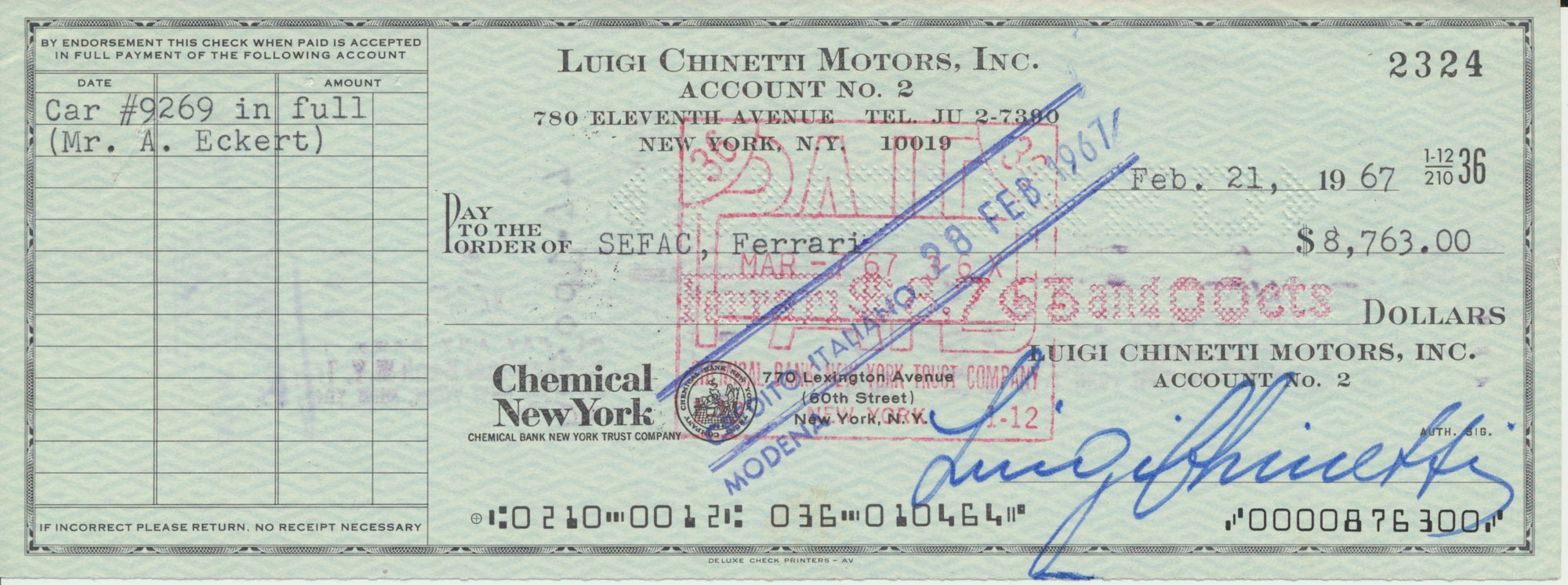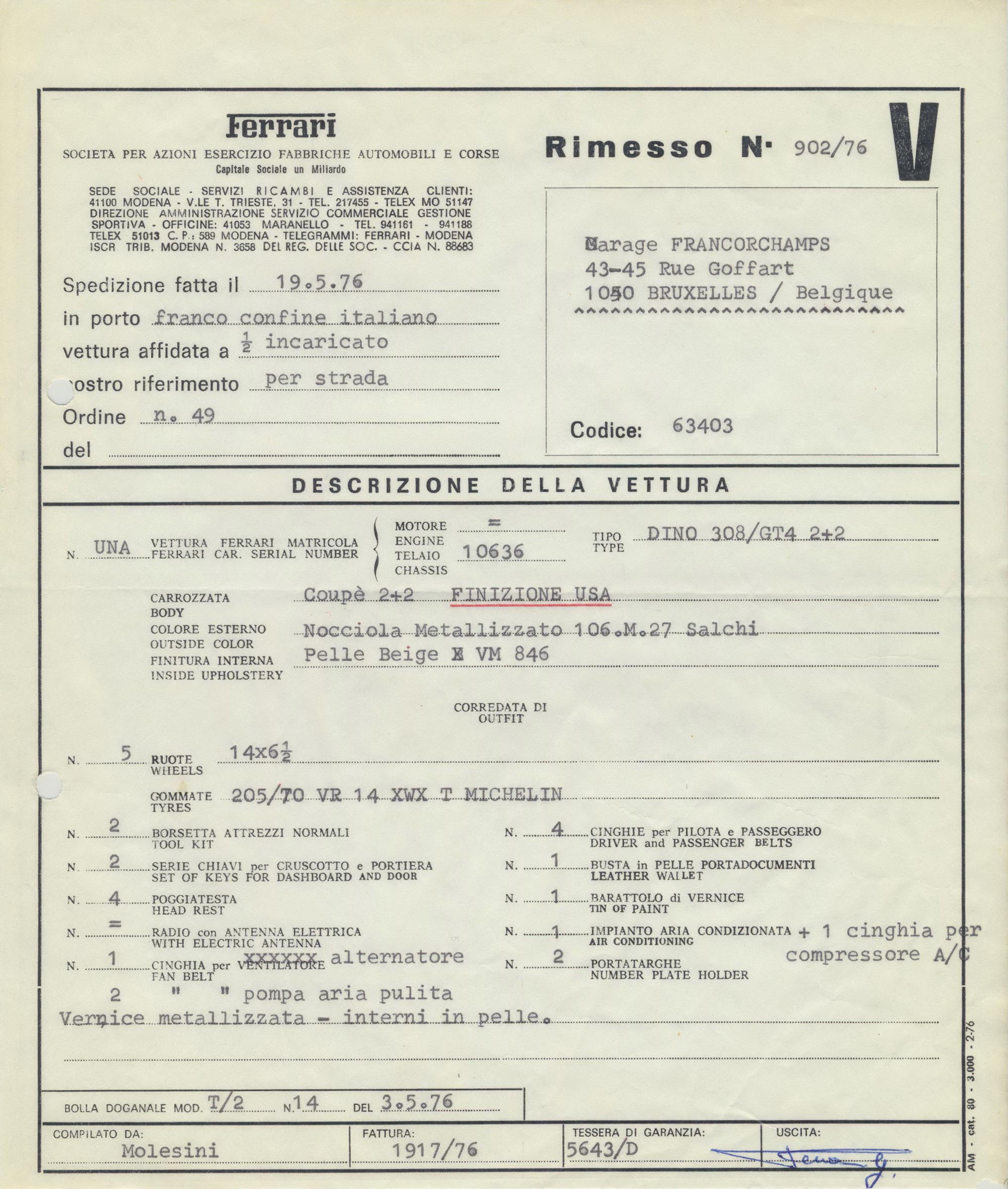the massini
report
Real detective work: meticulous data tracking and collection
by Ferrari historian Marcel Massini.
A Google search with zero results? Quite conceivable with Marcel Massini’s activity. The time traces of Classic Cars cannot simply be retrieved on the Internet at the click of a mouse, as we are used to doing in our everyday lives today. Because in keeping with the vehicles themselves, the information about them is also of a rather classic nature: analog. Reconstructing their life stories therefore requires a different approach – and passion. Massini was a big Ferrari fan from childhood and collected everything related to the Cavallino rapante. And over the years, this commitment developed into an impressive expertise. The foundation is formed by intensive research and the meticulous compilation of data: a wide variety of documents, such as old invoices from the purchase or service of the vehicles, correspondence from sellers and owners. Massini also owns a large library of Ferrari books, magazines, auction and parts catalogs, as well as 1.5 million digital photos, 150,000 black and white photos plus 60,000 color slides. He maintains this treasure trove of data as a physical as well as a digital archive – stored in a structured manner with precise assignment of chassis number, type, location, date and driver. According to Massini, something can always be found: for example, a cashier’s check from the American Ferrari importer Chinetti, who used it to buy a Ferrari 275 GTB4 in 1968. In addition to the chassis number and date, the purchase price of approx. 7000 dollars can also be seen on it – a lot of money in those days. Thus, each found object tells a new chapter. “I follow these Ferraris through all of their stops, collecting the puzzle pieces and putting them together to create as complete a picture as possible,” Massini explains. In the process, he translates the data into life stories and thus also learns about unpleasant moments such as accidents.
FERRARIS WITH AIR MILES
Massini’s research and assignments take him around the world: to Ferrari collectors and extraordinary personalities, who are often both narrators and inquisitive listeners. Getting to know and exchanging ideas with other people is something Massini values very much – and so is traveling. And often the Ferraris themselves have more air miles than road kilometers on the speedometer.
As a globetrotter, Massini also learns about the differences between countries: In America, it is completely normal to find out about the history of a Ferrari Classic Car in detail before buying it – whether by doing your own research or from a specialist, he says. “The American market is of course much bigger than the European one, and the collector mentality is also much more pronounced there than in Europe,” Massini sums up.
A good dossier is not necessarily the deciding factor for a purchase, but it is definitely an advantage as complementary documentation or even overall documentation of the vehicle for participation in a Concours d’Elégance such as Villa d’Este, Pebble Beach or others. It usually provides the curriculum vitae with a start at the Ferrari factory and documents such as the Foglio di montaggio, purchase invoices, correspondence from the first buyer, other contracts and, especially important, documentation of any remodeling work – for example, invoices for repainting or a new leather interior. Of course, it matters with whom these restorations were made. Shaking his head, Massini comments, “There are people who buy a Ferrari for $5 million, but then go to the garage around the corner to have it repainted.” Unlike Ferrari certifications, which primarily assess originality – that is, whether the car still has the original engine, transmission or rear axle, carburetors, wheels, etc. – Massini’s work tells the story around it, or as he puts it, “Everything the car has experienced from the moment it was driven out of the building in Maranello. Ferrari doesn’t know these experiences – that’s then my job, so to speak.”

IT’S A MATCH
Massini’s clients include the largest auction houses such as Artcurial Monaco, Gooding & Co, RM Sotheby’s and Bonhams, for which he pre-screens the Ferraris to be sold. Currently, Massini is accompanying the special case of a Ferrari 275 GTB, which unfortunately does not have an original engine. To restore it to its original condition, four cars of the same type are now involved: two in Switzerland, one in Belgium and one in America. Now the four owners have to be brought together and it has to be clarified whether it is possible to change the engines so that all the cars have matching numbers again – after all, this makes a price difference of 20%, and that’s not the only reason why it should be in the interest of every classic car owner to preserve the vehicle in its original condition as far as possible. But Massini is quick to dismiss this: “Worldwide coordination and different philosophies don’t always lead to a consensus.
CLASSIC CARS AS ART OBJECTS
Ferrari Classic Cars are not only represented at renowned auction houses, but are also exhibited as art objects at the Museum of Modern Art in New York or curated in exclusive collections – such as that of Ralph Lauren, which presents 30 Ferraris and about 120 other vehicles extremely aesthetically standing on pedestals. For Massini, this is more than understandable: “Ferrari’s history is highly interesting and very emotional. And a bit of drama is also part of it. You don’t buy a Ferrari just like that – just like a work of art,” he sums up.
Massini is also convinced that interest in Ferrari is almost self-perpetuating: people might start with a modern F8, and with time and more knowledge, they might later look for an older model like a 575 Maranello or a 612 Scaglietti. And then maybe a more classic one like a Daytona. The more you get involved with the Ferrari brand, the more variations that don’t really exist in any other car brand you get to know, Massini explains, concluding, “Passion for Ferrari takes time, enthusiasm and work – but it’s very fascinating!”
